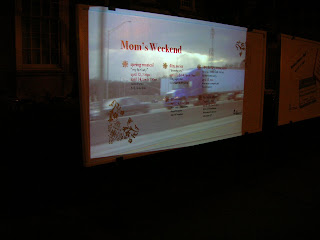

Due to the lack of specificity of the last trial we have decided to create individual paper sheets to place in each frame of the window in front of the Union instead of pulling paper sheets all the way across or having a screen to project on to. There are 90 frames in that central window, each one is the same size, roughly 11 X 18 3/4 inches. We plan to cut out the sheets and place them in the window frames. This way the projection will still be visible, but it will also reveal the structure of the window frames. It also relates better to our original idea of multiple tiny moments coming together to make a bigger picture of something more meaningful. In the frames we will project individual pictures instead of one big picture. Each image will fade to black until the whole projection is black, this will happen randomly and one at a time so the viewer must choose which images to give their time to. We feel that this method of display and visualization will comment better on the concept of a community contributing bringing their individual perceptions together, tiny memories combining to create a message about ephemerality and enjoying tiny moments. We also feel that the dissappearing aspect comments on the time element and acts as a metaphor about the passing nature of moments. This display will also be visible enough to attract attention from anywhere on the quad, but it since the images are in frames it will force people to come up close to look there by creating a specific viewing area/community on the veranda. Thes pictures are quick proposals of how it might look, the first is the old projection (1 image on the paper sheets) the second is how we want to do it with tiles of images in the frames.
















































